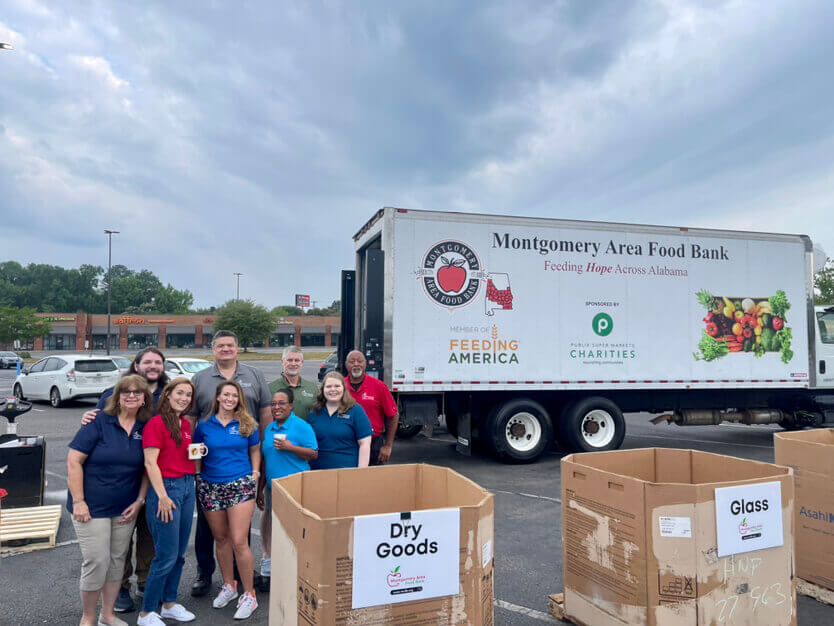No products in the cart.
Food bank in Alabama
Alleviating Hunger and Building Stronger Communities
Introduction:
Food insecurity remains a pressing issue in Alabama, affecting numerous individuals and families who struggle to access nutritious meals on a regular basis. In response to this ongoing challenge, food banks in Alabama play a crucial role in combating hunger and providing much-needed support to those in need. This article explores why food banks are needed in Alabama, how people can support these vital institutions, and highlights five special features of food banks in the state.
Why Foodbanks are Needed in Alabama
Food banks serve as essential resources for addressing hunger in Alabama by collaborating with food donors, pantries, and soup kitchens [1]. The state’s food banks heavily rely on donations from local food companies, government agencies, food drives, individual donors, and organizations like Feeding America [1]. These donations enable the food banks to acquire substantial amounts of food.
The demand for food aid has risen significantly due to the economic recession and high unemployment rates, making the presence of food banks even more critical [1]. Alabama food banks collectively supplied an impressive 48 million pounds of food to agencies in 2011 alone, underscoring the magnitude of their impact [1]. These institutions serve as a vital lifeline for individuals and families facing food insecurity, ensuring that they have access to nutritious meals.
How People Can Support Alabama Foodbanks
Support from the community is crucial to the continued success and sustainability of food banks in Alabama. There are several ways in which individuals can contribute and make a difference:
- Donations: Food banks welcome financial contributions, as each dollar donated can provide meals for four people [3]. Donations can be made online or by mail, allowing individuals to support these organizations in their mission to alleviate hunger [3].
- Volunteerism: Food banks often rely on volunteers to help with various tasks, such as sorting and distributing food, organizing food drives, or assisting with administrative work. By volunteering their time and skills, individuals can directly contribute to the efficient functioning of these organizations and make a tangible impact on the lives of those in need.
- Food Drives: Organizing or participating in food drives is an effective way to collect non-perishable food items for food banks. These drives can be organized in schools, workplaces, community centers, or religious institutions, allowing individuals to come together and support their local food banks.
- Awareness and Advocacy: Spreading awareness about hunger in Alabama and advocating for policies that address this challenge are important steps towards creating long-term solutions. By engaging in conversations, sharing information, and supporting initiatives aimed at ending hunger, individuals can contribute to the broader effort of building a more food-secure Alabama.
Some Prominent Foodbanks of Alabama:
The “Community Food Bank of Central Alabama” is a charitable organisation that distributes food to those in need in the Alabama counties. Since its inception in 1982, the organisation has made it one of its primary goals to meet the dietary requirements of individuals who are in need.
“The Food Bank of North Alabama” has been providing assistance to the people living in North Alabama ever since it was founded in 1984. The Food Bank gives out free food and other necessities, like as cleaning supplies and clothing, to low-income families, sick people, and children who participate in one of its 240 approved feeding programmes.
It is a non-profit organization founded in 1986 with the mission of locating, procuring, and distributing nutritious food to individuals in need in the 12 counties of Alabama’s River Region. They have collaborated with over 200 agencies and 575 partner organizations throughout the state to provide nutritious meals to the most vulnerable populations. The counties Elmore, Bullock, Autauga, Chilton, Butler, Lowndes, Coosa, Crenshaw, Macon, Montgomery, Pike, and Tallapoosa have access to their services. Over the course of the previous year, a staggering 26 million pounds of nourishment were allocated to individuals experiencing hardship.
Feeding the Gulf Coast is a non-profit organization serving Gulfport, Mississippi, Theodore, Alabama, and Milton, Florida. Together with 400 partner organizations, The organization collects, inspects, transports, and distributes food to those in need throughout the region. Their priority is to ensure that everyone, regardless of their circumstances, has access to nutritious sustenance.
West Georgia and Alabama residents are served by Feeding the Valley Food Bank, a non-profit organization. This food bank is one of Georgia’s eight regional food banks dedicated to ending starvation in their respective communities. The Feeding the Valley Food Bank adheres to the American Institute of Bakers International’s food safety standards.
Special Features of Foodbanks in Alabama
- Collaboration and Distribution Network: Alabama’s food banks collaborate with food donors, pantries, and soup kitchens to establish a comprehensive distribution network. They work closely with over 1,700 community partners, including soup kitchens and shelters, to ensure efficient delivery of food assistance to those in need, particularly children [1].
- Mobile Pantries and Direct Meal Programs: The Community Food Bank of Central Alabama utilizes Mobile Pantries and direct meal programs to reach vulnerable populations. These initiatives enable the food bank to extend its services directly to communities in need, ensuring that individuals have access to nutritious meals [3].
- Community Engagement and Support: Food banks in Alabama actively engage with the community and encourage financial contributions from individuals and businesses. The Community Food Bank of Central Alabama, for example, emphasizes that each dollar donated can provide meals for four people, highlighting the tangible impact of community support [3].
- Regional Coverage: Multiple food banks serve various counties in Alabama, ensuring that different regions have access to food assistance. Each food bank is responsible for serving specific counties, such as the Community Food Bank of Central Alabama serving twelve counties, the Food Bank of East Alabama serving six counties, and the Montgomery Area Food Bank serving ten counties [4].
- Specialized Assistance and Programs: Beyond providing food assistance, some food banks in Alabama offer additional support and programs. Triumph Youth and Adult Food Bank addresses community needs through emergency help, utility assistance, and literacy/GED preparation [5]. These additional initiatives aim to tackle the underlying causes of food insecurity and empower individuals and families to overcome adversity.
Conclusion
Food banks play a vital role in combating hunger and addressing food insecurity within the state of Alabama. Their collaborative efforts with food donors, community partners, and volunteers enable them to distribute millions of pounds of food annually, providing much-needed support to individuals and families in need. By supporting Alabama’s food banks through donations, volunteerism, food drives, and advocacy, individuals can play an active role in alleviating hunger and building stronger, more resilient communities.





Add Comment
You must be logged in to post a comment.